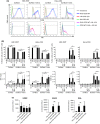Predominance of the heterozygous CCR5 delta-24 deletion in African individuals resistant to HIV infection might be related to a defect in CCR5 addressing at the cell surface
- PMID: 31486251
- PMCID: PMC6727025
- DOI: 10.1002/jia2.25384
Predominance of the heterozygous CCR5 delta-24 deletion in African individuals resistant to HIV infection might be related to a defect in CCR5 addressing at the cell surface
Abstract
Introduction: The chemokine receptor CCR5 is the main co-receptor for R5-tropic HIV-1 variants. We have previously described a novel 24-base pair deletion in the coding region of CCR5 among individuals from Rwanda. Here, we investigated the prevalence of hCCR5Δ24 in different cohorts and its impact on CCR5 expression and HIV-1 infection in vitro.
Methods: We screened hCCR5Δ24 in a total of 3232 individuals which were either HIV-1 uninfected, high-risk HIV-1 seronegative and seropositive partners from serodiscordant couples, Long-Term Survivors, or HIV-1 infected volunteers from Africa (Rwanda, Kenya, Guinea-Conakry) and Luxembourg, using a real-time PCR assay. The role of the 24-base pair deletion on CCR5 expression and HIV infection was assessed in cell lines and PBMC using mRNA quantification, confocal analysis, flow and imaging cytometry.
Results and discussion: Among the 1661 patients from Rwanda, 12 individuals were heterozygous for hCCR5Δ24 but none were homozygous. Although heterozygosity for this allele may not confer complete resistance to HIV-1 infection, the prevalence of the mutation was 2.41% (95%CI: 0.43; 8.37) in 83 Long-Term Survivors (LTS) and 0.99% (95%CI: 0.45; 2.14) in 613 HIV-1 exposed seronegative members as compared with 0.35% (95% Cl: 0.06; 1.25) in 579 HIV-1 seropositive members. The prevalence of hCCR5Δ24 was 0.55% (95%CI: 0.15; 1.69) in 547 infants from Kenya but the mutation was not detected in 224 infants from Guinea-Conakry nor in 800 Caucasian individuals from Luxembourg. Expression of hCCR5Δ24 in cell lines and PBMC showed that the hCCR5Δ24 protein is stably expressed but is not transported to the plasma membrane due to a conformational change. Instead, the mutant receptor was retained intracellularly, colocalized with an endoplasmic reticulum marker and did not mediate HIV-1 infection. Co-transfection of hCCR5Δ24 and wtCCR5 did not indicate a transdominant negative effect of CCR5Δ24 on wtCCR5.
Conclusions: Our findings indicate that hCCR5Δ24 is not expressed at the cell surface. This could explain the higher prevalence of the heterozygous hCCR5Δ24 in LTS and HIV-1 exposed seronegative members from serodiscordant couples. Our data suggest an East-African localization of this deletion, which needs to be confirmed in larger cohorts from African and non-African countries.
Keywords: AIDS; Africa; CCR5; HIV-1; mutation; receptor expression.
© 2019 The Authors. Journal of the International AIDS Society published by John Wiley & Sons Ltd on behalf of the International AIDS Society.
Figures




References
-
- Berger EA, Murphy PM, Farber JM. Chemokine receptors as HIV‐1 coreceptors: roles in viral entry, tropism, and disease. Annu Rev Immunol. 1999;17:657–700. - PubMed
-
- Verhofstede C, Nijhuis M, Vandekerckhove L. Correlation of coreceptor usage and disease progression. Curr Opin HIV AIDS. 2012;7(5):432–9. - PubMed
Publication types
MeSH terms
Substances
LinkOut - more resources
Full Text Sources
Medical

